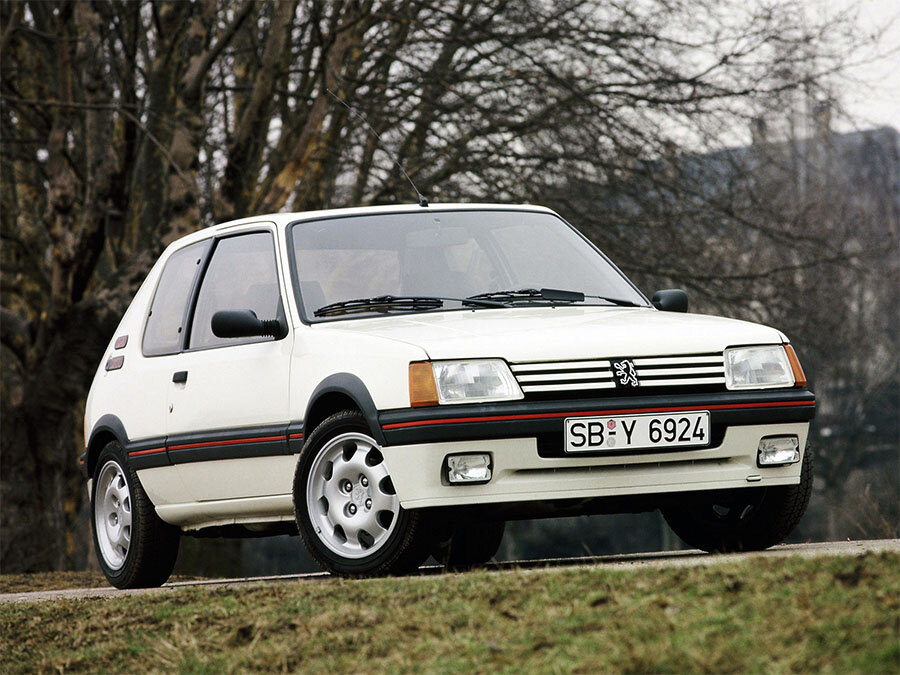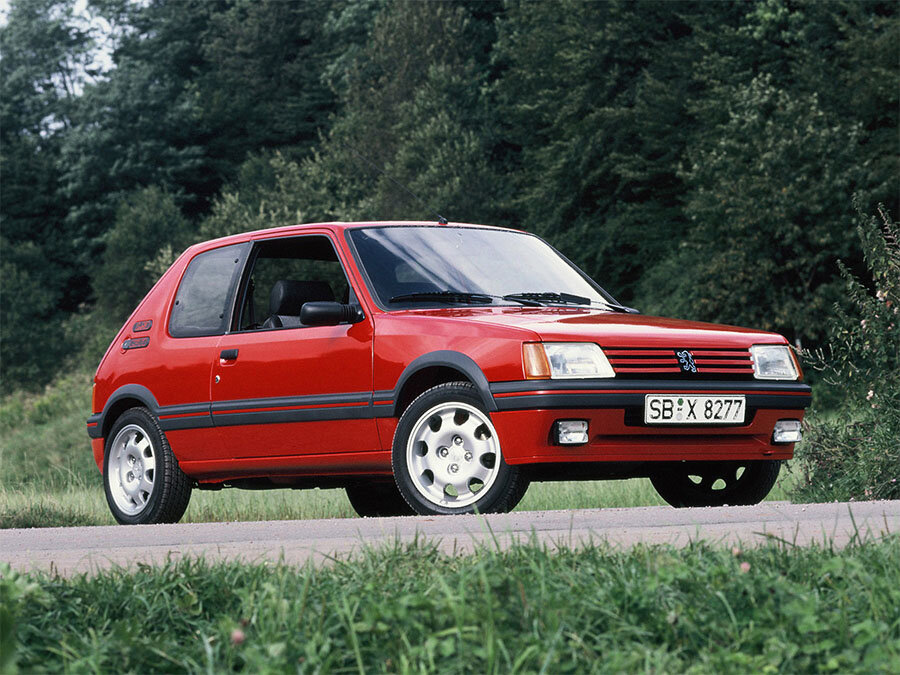Guide: Peugeot 205 GTi 1.9
Background
When the 205 arrived in 1983, it quickly began to turn Peugeot’s fortunes around.
Although the firm was not in a perilous financial state, it had acquired a somewhat stuffy image thanks to a back catalogue of unexciting models that stretched back many years.
It had not always been this way. In the late 19th century, Peugeot had pioneered a number of advanced technical features and, in 1894, won the world’s first motor race from Paris to Rouen.
In 1912, Peugeot moved up to Grand Prix racing with an engineering tour de force: a dual overhead camshaft 7.6-litre engine with four valves per cylinder. Much success followed before and after World War 1.
Since then, Peugeot had failed to produce a sporting model. Instead, the company churned out utilitarian automobiles that generally sold extremely well but failed to make the heart flutter.
The early 205 won plaudits for its styling, ride and handling. However, Peugeot’s image was really reinvigorated by some high performance road-going iterations of the 205 and a state-of-the-art Group B rally variant.
The Group B 205 T16 was unveiled in prototype for at the original 205 launch in February 1983. The mid-engined, four-wheel projectile quickly established itself as the dominant force in the World Rally Championship. However, as only 200 production car were required for homologation, the T16 was not going to directly affect the bottom line of Peugeot or its dealers.
Instead, to capitalise on the sporting prowess of its rally-winner, Peugeot created a hot version of the standard front-wheel drive 205 – something in a similar vein to Volkswagen’s all-conquering Golf GTi.
The 205 GTi was launched to critical acclaim in April 1984. With its sporty bodywork additions and uprated specification, the 205 GTi looked like a baby T16 but offered sizzling performance at a price that many people could afford.
In its original guise, the 205 GTi was offered with a 1.6-litre engine, close-ratio gearbox and 14-inch diameter wheels. Disc brakes were fitted at the front only, the suspension was fairly compliant and the interior specification was fairly basic.
In December 1986, all of these features were upgraded when a new 1.9-litre variant was added to the range.
Chassis
Like the 1.6, the 1.9-litre GTi was based around a three-door zinc galvanised steel bodyshell for which Peugeot offered a six-year anti-corrosion warranty. The wheelbase measured 2420mm and thanks to some innovative design, there was plenty of space for five adults.
Suspension was independent all round. At the front, Peugeot fitted MacPherson struts, coil springs and lower wishbones. The back end used trailing arms fixed to a single beam, transverse torsion bars and telescopic shocks absorbers.
For the original GTi, Peugeot had lowered the ride height, fitted stiffer shocks and springs and different wishbones. Anti-roll bars were installed at either end.
To reduce pitch and roll and tame the oversteer the 1.6 had become famous for, the 1.9 came with further stiffened suspension which resulted in a slightly harsher ride.
Whereas the 1.6 used a disc / drum brake arrangement at the front / rear, the 1.9 GTi ran discs all round. They were the same 247mm diameter type used on the 1.6 but the calipers and pads were new (albeit to effectively the same specification as the entry level model).
Perhaps the easiest way to identify the new variant was by its new 15-inch Speedline SL299 wheels. They replaced the 14-inch rims used on the 1.6 although the smaller ‘Pepperpot’ wheels were retained for certain export markets such as Australia, Japan, Sweden and Switzerland.
The same 50-litre fuel tank located under the rear seat was shared by both cars.
Engine & Gearbox
Mounted transversely in the engine bay was a new XU9JA-D6B engine. As per the 1.6-litre variant, it was an all-alloy water-cooled Inline 4 with a belt-driven single overhead camshaft, two valve cylinder head and wet-sump lubrication.
To stretch the displacement from 1.6 to 1.9-litres, the stroke was extended from 73mm to 88mm. Bore remained at 83mm. This gave an overall capacity of 1905cc which was an increase of 325cc.
The compression ratio was reduced from 9.8:1 to 9.6:1.
Bosch LE2 Jetronic multipoint fuel-injection was retained.
Overall, the new engine produced more power and torque but, as a result of the longer stroke, its delivery was lazier than the revvy little 1.6.
Peak output was 130bhp at 6000rpm and 119lb-ft at 4750rpm. For comparison, the entry level variant produced 115bhp at 6250rpm and 99lb-ft at 4000rpm.
Unlike the 1.6, which could run on 95 RON fuel, 98 RON gas was required for the 1.9-litre engine.
The five-speed ‘box was fitted with longer ratios on first, second and fifth gears. A single-plate clutch was once again employed.
Bodywork
Aside from 1.9 badges on the C-pillars and the aforementioned 15-inch Speedline wheels, the new flagship model looked identical to the 1.6.
Both cars shared the same dark grey plastic bumpers that were accessorised with bright red inserts. Matching dark grey and red mouldings were fitted down each flank along with dark grey plastic wheelarch extensions.
The same body coloured aprons were used along with Siem front spot lights.
Other special dark grey plastic body trim fitted to the GTi variants included unique exterior mirrors, special C-pillar badges, a horizontally fluted panel between the tail lights and a black rubber spoiler at the top of the rear windscreen.
Interior
Inside, the 1.9-litre GTi was enhanced with electric windows and half leather trim as standard.
The grey leather upholstery featured red stitching on the bolsters and headrests. Quattro fabric seat centres incorporated a red stripe through the middle.
Otherwise, the specification was identical to the 1.6.
A chunky two-spoke sports steering wheel embossed with the GTi logo fronted a rectangular instrument binnacle. This housed a large speedometer and a rev counter that were flanked on the outside by smaller read outs for oil pressure, fuel level, water temperature and oil temperature. The entire dash assembly was formed in grey plastic.
The lever-type ventilation controls were located above the radio and below a bank of switches on the centre console.
Red carpet was used for the floor with red and dark grey fabric elsewhere.
Options
Options included fabric upholstery, a sunroof, rubber floor mats and a choice of five exterior colours (Alpine White, Cherry Red, Graphite Grey, Silver and Black). Audio systems were frequently installed by the supplying dealer as were the likes of mud flaps. Another dealer fit option was a red reflective tail panel to replace the original fluted grey tailgate trim.
Weight / Performance
At 875kg, the 1.9 weighed 25kg more than the 1.6. Top speed went from 120mph to 128mph and the 0-62mph time dropped from 8.5 seconds to 7.8 seconds.
Production Changes
The first updates arrived in October 1987 when a series of changes were made to both the 1.6 and 1.9-litre models. Most significantly, the dash was subtly redesigned and a neat new central console panel was added. The centre console now featured rotary instead of sliding ventilation controls along with revamped switchgear. Externally, the original adhesive rear spoiler was changed to a simplified screw on type.
A new gearbox was phased in from August 1989. Whereas reverse gear had originally been off to the left on its own, it was now directly opposite fifth. A slightly bigger exhaust was added at the same time and the electric window switches became illuminated.
From October 1989, the 1.9-litre engine could be optionally specified with a catalytic converter. Catalysed cars came with a new XU9JA-Z-DKZ engine that featured Bosch Motronic M1.3 management and a lower compression ratio (9.2:1 instead of 9.6:1). Power dropped from 130bhp to 122bhp at an unchanged 6000rpm. The torque rating went from 111lb-ft at 4000rpm to 119lb-ft at 4750rpm.
At the same time, a power steering option was introduced.
Power steering was immediately bundled in as part of the Sorrento Green and Miami Blue special editions that were launched at the same time. These cars also came with a sliding sunroof, full grey leather, grey carpet and grey door cards. 600 of each variant were built. Production was split 50/50 between the 1.6 and 1.9-litre engine.
Another major development arrived in September 1990 when anti-lock brakes were introduced as an option. Cosmetically, things were freshened up too: the bumpers, wheelarch extensions and side mouldings were made blacker, clear front indicators were added, the tail light clusters were redesigned and the reverse light was moved to the bumper.
Around the same time, Topaz Blue was temporarily added to the list of exterior colour options.
Laser Green Metallic was the next new colour to arrive in October 1990. Upon introduction, Laser Green Metallic could be ordered as part of the very high specification Griffe special edition that was available exclusively with the 1.9-litre engine.
The Griffe was a European market variant sold in France, Germany and Holland. In addition to Laser Green Metallic paint, it came with full black leather upholstery, anti-lock brakes, power steering and a sunroof. The wheels were finished with dark grey anodised centres and silver rims. 3000 were built (1000 for each country).
In October 1991, air-conditioning was added to the options list. Remote central locking and a warning buzzer for the headlights became standard.
Production of the 1.6-litre 205 GTi was discontinued on emissions grounds in September 1992.
From October 1992, the 1.9 was only offered in catalysed trim and grey carpets became standard.
Soon after, a special 1FM edition was produced for the UK market.
Built to celebrate the 25th birthday of BBC Radio 1, 25 examples were made to an identical specification. Standard equipment included Black paint with Radio 1FM 25th decals on the tailgate and doors. Also bundled in were wheels with grey anodised centres, full leather upholstery, air-conditioning, power steering and a commemorative brass plaque. A special Clarion six-speaker stereo with remote control was fitted along with a trunk-mounted CD shuttle, an acoustic rear parcel shelf and body coloured lower tail panel instead of the fluted grey plastic trim fitted to the regular version.
Shortly before production ended in April 1994, a keypad immobiliser was introduced.
End of Production
By the time the last 205 GTi rolled off the production line, 61,653 had been completed in 1.6 and 1.9 trim.
Text copyright: Supercar Nostalgia
Photo copyright: Peugeot - http://www.peugeot.com





































